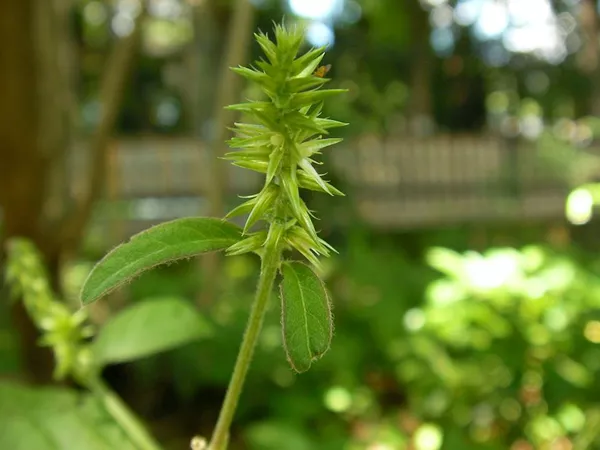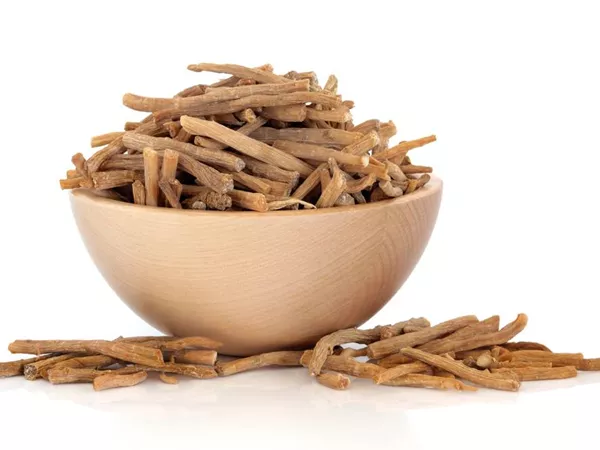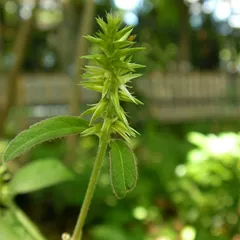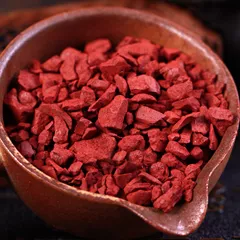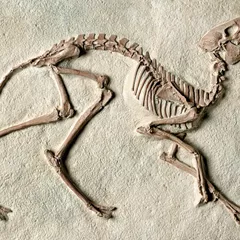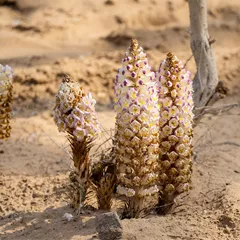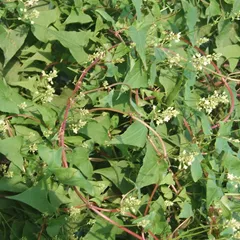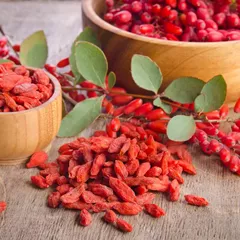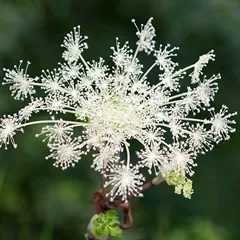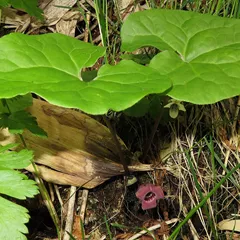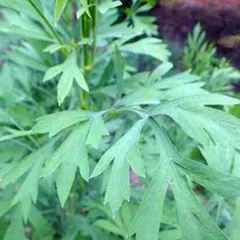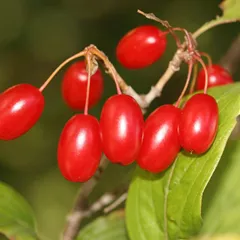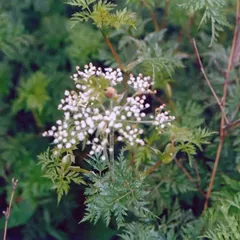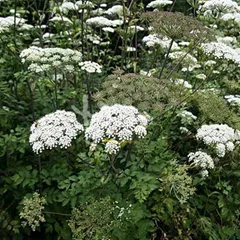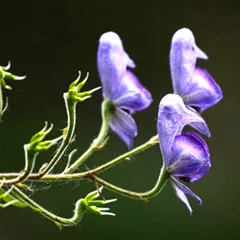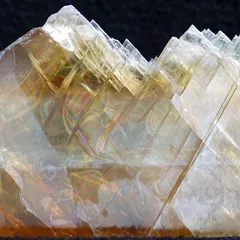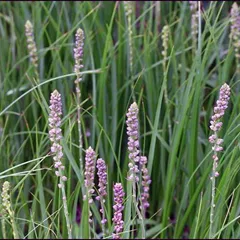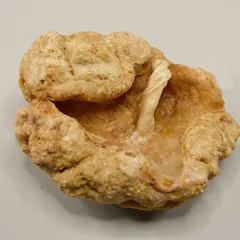Use of Niu Xi (achyranthes roots) in TCM
Please note that you should never self-prescribe TCM ingredients. A TCM ingredient is almost never eaten on its own but as part of a formula containing several ingredients that act together. Please consult a professional TCM practitioner, they will be best able to guide you.
Preparation: Remove impurities, wash, cut into sections and dry.
Dosage: 6 - 9 grams
Main actions according to TCM*: Moves Blood and relieves pain in the raw state. Tonic to the Liver and Kidneys and strengthens the bones and sinews. Reduces Damp-Heat in the Lower Burner. Regulates the flow of reckless Blood caused by either ascendant Liver Yang or Yin Deficient Fire.
Primary conditions or symptoms for which Niu Xi may be prescribed by TCM doctors*: Amenorrhea Knee pain Irregular menstruation Back pain Hematuria Nosebleed Bloody sputum Headache Toothache
Contraindications*: Should not be used by pregnant women and should be used with caution by those with weak digestion and Spleen Deficiency.
Common TCM formulas in which Niu Xi is used*
Zhen Gan Xi Feng Tang
Source date: 1918 AD
Number of ingredients: 12 herbs
Formula key actions: Sedates the Liver. Axtinguishes Wind. Nourishes the Yin. Anchors the yang.
Conditions targeted*: HypertensionRenal hypertension and others
Niu Xi is a king ingredient in Zhen Gan Xi Feng Tang. Like the name indicates, it means it has more power than other ingredients in the formula.
In Zhen Gan Xi Feng Tang, Niu Xi conducts the circulation of Blood downward, separating the Blood from the ascendant Yang. It also tonifies and nourishes the Liver and Kidneys.
Ji Chuan Jian
Source date: 1624 AD
Number of ingredients: 6 herbs
Formula key actions: Warms the Kidneys . Nourishes the Blood . Strengthens the Essence . Moistens the Intestines. Unblocks bowels .
Conditions targeted*: ConstipationConstipation in the elderly and others
Niu Xi is a deputy ingredient in Ji Chuan Jian. This means it helps the king ingredient(s) treat the main pattern or it serves to treat a coexisting pattern.
In Ji Chuan Jian, Niu Xi strengthens the lower back and the Kidneys. It also has a descending nature that focuses the
actions of the formula on the Lower Burner.
Qi Bao Mei Ran Dan
Source date: 1590 AD
Number of ingredients: 9 herbs
Formula key actions: Enriches the Kidney Yin. Nourishes the Liver Blood.
Conditions targeted*: AlopeciaPremature graying of the hair and others
Niu Xi is a deputy ingredient in Qi Bao Mei Ran Dan. This means it helps the king ingredient(s) treat the main pattern or it serves to treat a coexisting pattern.
In Qi Bao Mei Ran Dan, Niu Xi strengthens the sinews and bones in general, especially on the
lower back and knees.
Du Huo Ji Sheng Tang
Source date: 650 AD
Number of ingredients: 15 herbs
Formula key actions: Anti-rheumatic, clears Wind, Cold and Damp Stagnation. Strengthens the function of the Liver and Kidney. Tonifies Qi and Blood.
Conditions targeted*: Chronic lower back painSciatica and others
Niu Xi is an assistant ingredient in Du Huo Ji Sheng Tang. This means that it either serves to reinforces the effect of other ingredients or it moderates their toxicity.
Zuo Gui Wan
Source date: 1624 AD
Number of ingredients: 8 herbs
Formula key actions: Nourishes the Yin. Strengthens the Kidneys. Fills the Essence. Augments the marrow.
Conditions targeted*: Chronic bronchitisChronic nephritis and others
Niu Xi is an assistant ingredient in Zuo Gui Wan. This means that it either serves to reinforces the effect of other ingredients or it moderates their toxicity.
In Zuo Gui Wan, Niu Xi augments the Liver and Kidneys, strengthens the back and knees, as well as builds the sinews and bones.
Shu Jing Huo Xue Tang
Source date: 1587 AD
Number of ingredients: 16 herbs
Formula key actions: Expels Wind Damp from the Channels. Invigorates Blood. Unblocks the channels.
Conditions targeted*: ArthralgiaBell's palsy and others
Niu Xi is an assistant ingredient in Shu Jing Huo Xue Tang. This means that it either serves to reinforces the effect of other ingredients or it moderates their toxicity.
In Shu Jing Huo Xue Tang, Niu Xi invigorates the Blood circulation through the vessels so as to relieve symptoms such as headache, dizziness, blurred vision and pain.
Da Fang Feng Tang
Source date: 1107 AD
Number of ingredients: 14 herbs
Formula key actions: Expel Wind Damp. Relieve pain. Tonify the Liver and the Kidneys. Tonify the Blood and Qi.
Conditions targeted*: ArthralgiaCommon cold and others
Niu Xi is an assistant ingredient in Da Fang Feng Tang. This means that it either serves to reinforces the effect of other ingredients or it moderates their toxicity.
In Da Fang Feng Tang, Niu Xi warms and tonifies the Liver as well as the Kidneys. It also strengthens the Channels, bones and tendons.
Yu Nu Jian
Source date: 1624 AD
Number of ingredients: 5 herbs
Formula key actions: Drains Heat from the Stomach. Nourishes Yin.
Conditions targeted*: StomatitisGlossitis and others
Niu Xi is an envoy ingredient in Yu Nu Jian. This means that it directs the formula towards certain area of the body and/or harmonizes the actions of other ingredients.
In Yu Nu Jian, Niu Xi directs the Heat downward by guiding Blood downward and thereby stops Blood flowing into the oral cavity.
He Che Da Zao Wan
Number of ingredients: 11 herbs
Formula key actions: Tonifies the Kidneys. Strengthens the Directing and Penetrating Vessels. Regulates the periods.
Da Ying Jian
Source date: 1624 AD
Number of ingredients: 7 herbs
Formula key actions: Tonifies Qi and Blood. Expels Cold.
In Da Ying Jian, Niu Xi nourishes the Liver and invigorates Blood
Dang Gui Di Huang Yin
Source date: 1640 AD
Number of ingredients: 7 herbs
Formula key actions: Nourishes Blood. Tonifies Kidney and Liver Yin. Regulates the menstrual cycle.
In Dang Gui Di Huang Yin, Niu Xi nourishes the Kidneys and strengthens the back and knees
Key TCM concepts behind Niu Xi's properties
In Traditional Chinese Medicine (TCM), Niu Xi belongs to the 'Herbs that invigorate the Blood' category. Like the name indicates these herbs tend to stimulate the Blood flow. In TCM they're used to help the circulation of Blood in cardiovascular conditions or menstrual irregularities as well as to treat acute pains caused by Blood Stagnation. They can also be used to treat Blood Stagnation when it causes certain tumors, cysts and hardened clots.
Furthermore Niu Xi is Neutral in nature. This means that Niu Xi typically doesn't affect the balance in your body. Balance between Yin and Yang is a key health concept in TCM. Eating too many "Hot" (Yang) ingredients can lead to an imbalance whereby one has a Yang Excess. The inverse is true as well: too many "Cold" (Yin) ingredients can lead to a Yin Excess. The Neutral nature of Niu Xi means that you don't have to worry about that!
Niu Xi also tastes Bitter and Sour. The so-called 'Five Phases' theory in Chinese Medicine states that the taste of TCM ingredients is a key determinant of their action in the body. Bitter ingredients like Niu Xi tends to have a cleansing action on the body by clearing Heat, drying Dampness and promoting elimination via urination or bowel movements. On the other hand Sour ingredients help with digestion and restrain abnormal discharges of Fluids from the body, such as diarrhea or heavy sweating.
The tastes of ingredients in TCM also determine what Organs and Meridians they target. As such Niu Xi is thought to target the Kidney and the Liver. According to TCM, the Kidneys do not only regulate the urinary system but also play a key role in the reproductive system and the growth and aging process of the body. The Liver on the other hand is often referred as the body's "general" because it is in charge of regulating the movements of Qi and the Body Fluids. It also takes a leading role in balancing our emotions.
Research on Niu Xi
Achyranthes bidentata polysaccharides (ABP), isolated from the root of Achyranthes bidentata Blume inhibited the growth of sarcoma 180 in mice and prolongated the survival days of mice bearing Ehrlich carcinoma.1
Sulfation of Achyranthes bidentata polysaccharide was shown to have high activity as anti-HBsAg and HBeAg. It is also effective on simple herpes virus type-I.2
Sources:
1. Xiang DB, Li XY (1993). Antitumor activity and immuno-potentiating actions of Achyranthes bidentata polysaccharides. Zhongguo yao li xue bao = Acta Pharmacologica Sinica, 14(6):556-561
2. Tian GY, Li ST, Song ML, Zheng MS, Li W (1995). Synthesis of Achyranthes bidentata polysaccharide sulfate and its antivirus activity. Yao xue xue bao = Acta Pharmaceutica Sinic, 30(2):107-111.

